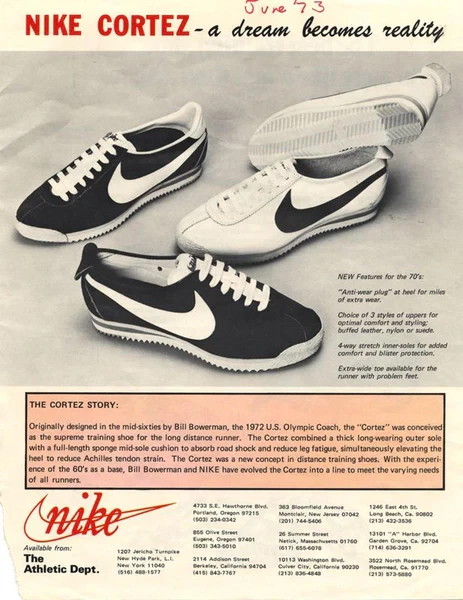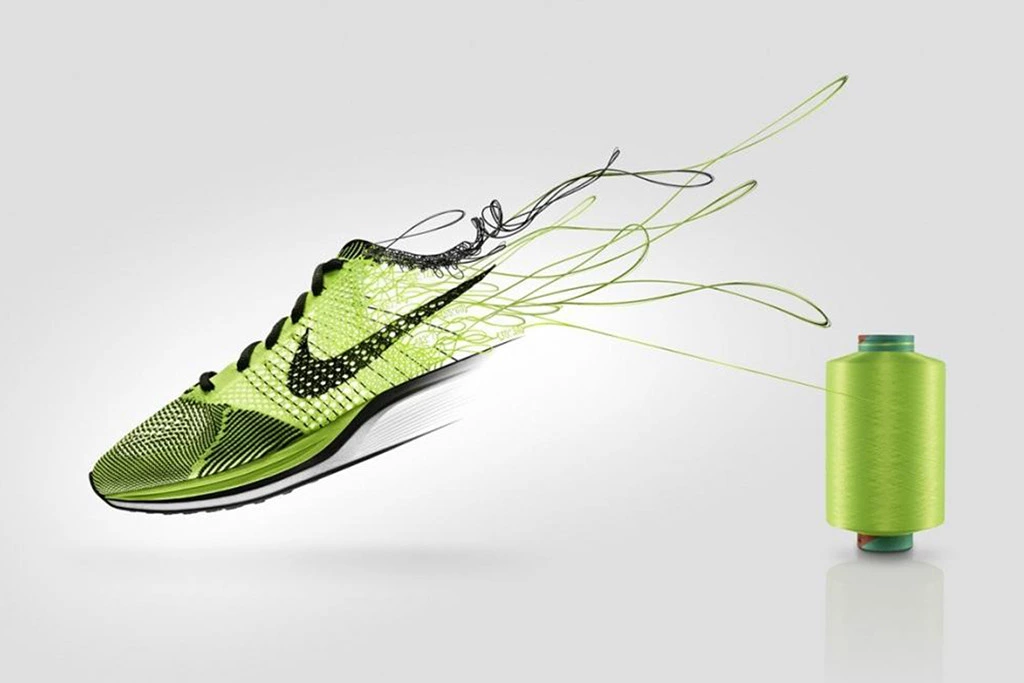Founded in 1964 by Bill Bowerman and Phil Knight, Nike has grown to become one of the most recognizable and respected sports brands in the world. From its humble beginnings as a distributor for a Japanese shoe maker to its current status as a global leader in the sportswear industry, Nike has a rich history of innovation, style, and success.
This article takes a look at some of the most notable events and innovations in Nike’s history, as well as its ongoing commitment to sustainability and technology. Through this article, we will explore Nike’s evolution through time, giving readers an overview of the company’s history, notable product releases, collaborations, business moves, and future plans.
1964

Blue Ribbon Sports is founded by Bill Bowerman and Phil Knight. The company originally served as a distributor for Japanese shoe maker Onitsuka Tiger (now ASICS). Phil Knight, an accountant and former track coach, and Bill Bowerman, a track and field coach, had a shared passion for sports and they envisioned a company that would provide high-quality athletic shoes at affordable prices.
1971

The company officially changes its name from Blue Ribbon Sports to Nike. The brand’s name, inspired by the Greek goddess of victory, Nike, is meant to evoke a sense of victory and success. The name change was suggested by one of the company’s employees Jeff Johnson who was also the first full-time employee of the company, who had been inspired by the Greek goddess of victory.

The same year, the iconic “Swoosh” logo was also introduced, it was designed by Carolyn Davidson, a graphic design student, who was working on a class project for a design course at Portland State University. The logo was created as a simple yet striking design, that would be easy to recognize, and that could be used in a variety of contexts.
The Swoosh logo quickly became one of the most recognizable logos in the world, appearing on all Nike products and marketing materials, it also became an immediate success. It is an elegant and minimal design that allowed Nike to be easily recognized, it also allowed for the focus to be on the product and message rather than the logo itself.
1972
The Nike Cortez, designed by Bill Bowerman, is released as the company’s first running shoe. Bowerman was a co-founder of Nike, and a track and field coach, who was looking for ways to improve the performance of his athletes’ shoes. He turned to experimentation and innovation as a way to achieve this, experimenting with different materials, constructions, and designs for his shoes.

The Cortez was one of the first running shoes to feature Bowerman’s innovations, such as the waffle outsole, which provided better traction, and the grooved midsole, which helped reduce weight. These design elements helped improve the shoe’s performance and comfort, and they became key features of many of Nike’s later shoes.
The Cortez was a success and it helped to solidify Nike’s position as a leading brand in the athletic footwear market. The shoe was worn by many runners and it became one of the most popular running shoes of the 1970s. It was also one of the first shoes to be mass-produced, which helped to bring down the price and make it more accessible to runners of all levels.

The Cortez was also well known for its long-lasting durability and comfort, the shoe’s popularity was not limited to the running community and it became a lifestyle shoe. It was worn by celebrities, featured in movies and TV shows, and it become an iconic style and cultural symbol.
The Cortez remains a popular shoe and it’s still in production today, with various iterations and designs being released over the years, which are still being sought after by enthusiasts and collectors.
1978
Nike introduces the Air cushioning technology. This technology, was originally used in the Tailwind running shoe, and it featured a pouch of pressurized gas encased in foam, providing cushioning and support for the foot. This technology was later used in other Nike models such as the Air Force 1 and Air Jordan 1, which was the first signature shoe for Michael Jordan, and it was released in 1985.

The Air Jordan line became a cultural phenomenon, with each new release becoming highly sought after by sneaker enthusiasts. These releases became must-have items for collectors, as well as being worn by many as a status symbol. The Air Jordan line continues to be one of the most successful and recognizable lines of sneakers in the world, with new models and collaborations being released regularly.
1987
Nike introduces the Air Max line, which is considered one of the most iconic and recognizable sneakers in the world. The Air Max line features a visible air-cushioning unit in the heel, which provides cushioning and support for the foot, and it has become one of the brand’s flagship lines. The Air Max 1 was the first shoe to feature this visible air-cushioning unit, and it was designed by Tinker Hatfield, one of Nike’s most celebrated designers. The shoe was an instant success, and it quickly became a cultural icon and an inspiration for future Air Max designs.
The Air Max 90, which was released in 1990, was one of the most popular models of the line. The shoe was designed by Hatfield and it featured a bulky, chunky silhouette, and it was available in a variety of colorways. The Air Max 90 also incorporated materials such as mesh and leather to give the shoe a more premium feel.

Since the introduction of the Air Max 1, the line has been subject to many new iterations, designs, and innovations. Nike has released a wide range of Air Max models throughout the years, each one with its own distinct characteristics and features. Some of the most notable releases in recent years include the Air Max 270, which was the first Air Max shoe designed specifically for lifestyle wear and it has a heel unit that is more than twice the size of previous Air Max heel units, and the Air Max 720, which features Nike’s tallest Air unit to date.
The Air Max line is considered one of the most influential sneakers lines in the world, and continues to be popular among sneaker enthusiasts and fans worldwide.
1988
The company debuts its “Just Do It” slogan and advertising campaign. The campaign was first used in a television commercial that aired during the 1988 Summer Olympics and it was created by advertising agency Wieden+Kennedy. The slogan, “Just Do It,” was intended to encourage and motivate people to take action and to inspire them to achieve their goals.

The “Just Do It” campaign was extremely successful and it helped to solidify the Nike brand as a cultural icon. The slogan and the accompanying advertisements were widely recognized and remembered, and it became synonymous with the Nike brand. The slogan was used in a variety of contexts, from television commercials to billboards to social media posts.
The campaign also featured many high-profile athletes and celebrities, such as Michael Jordan, Bo Jackson, and Tiger Woods. The campaign featured them in their respective sports, emphasizing their strength, dedication, and achievement to inspire the viewers to reach their own potentials.
The slogan and campaign helped to establish Nike as a brand that’s associated with inspiration, motivation, and achievement. The slogan “Just Do It” still used today in various advertising and branding campaigns. The campaign was not only successful in its primary goal, which was to increase sales but it also helped Nike to establish an emotional connection with its customers, becoming a household name that transcends sports and lifestyle.
1992
Nike introduces Dri-FIT technology for moisture-wicking fabric, which is widely used in Nike’s performance apparel. Dri-FIT technology is designed to keep athletes cool and dry during their activities by pulling sweat away from the skin and moving it to the fabric’s surface, where it can evaporate. This helps to keep the athlete comfortable and to prevent chafing and irritation caused by moisture buildup.
The technology was developed in-house by Nike’s research and development team, who were looking for ways to improve the performance of athletic apparel. Dri-FIT fabric is made from a combination of polyester and spandex or nylon, which provides the fabric with its moisture-wicking properties. It is a proprietary technology owned by Nike
Dri-FIT quickly became a popular choice for athletes and sports enthusiasts, it was used in a variety of sports clothing such as shirts, shorts, and tights, and it was adopted by many sports teams and organizations. Dri-FIT was also used in other lines of clothing, such as casual wear and even uniforms for people who work in physically demanding fields.
Today, Dri-FIT is one of the most recognizable and successful moisture-wicking technologies on the market, with many other brands using similar technologies. Nike continuously improves and develop the technology further, adding new features such as UV protection, anti-odor properties and more to keep up with the athletes needs and to make the technology more versatile.
2002
The Nike SB line is introduced, targeting Skateboarders. The line features a variety of shoes, clothing, and accessories specifically designed for skateboarding, with heavy collaboration and partnership with some of the biggest Skateboarders of the era. The Nike SB line was first introduced with the Dunk SB model, which was based on the classic Dunk basketball shoe but was modified to meet the needs of skateboarders, such as using reinforced stitching in high-wear areas and adding Zoom Air cushioning in the sole for added impact protection.

The Nike SB line quickly gained popularity among skateboarders, not just for its durability and skate-specific features but also for its collaborations and partnerships with key skateboarders such as Eric Koston, Paul Rodriguez, Stefan Janoski and Lance Mountain among others.
The Nike SB line has expanded to include a wide range of shoes, clothing, and accessories, and it has become one of the most respected and sought-after brands in the skateboarding industry. The line has also been known for its limited edition releases and collaborations with artists, graphic designers, and even other fashion brands.
In addition to its products, Nike SB also supports skaters through its Nike SB Skateboarding program, which supports skate communities and events around the world, as well as providing a platform for skaters to showcase their talents and connect with fans.
2006
The company launched Nike+, a platform that was designed to allow runners to track their progress, and share their runs with friends. The platform includes a sensor that can be placed inside the shoe, which syncs with an accompanying mobile app. The sensor tracks a variety of data points such as distance, pace, time, and calories burned, which the user can view on their phone or computer. The Nike+ platform also allows users to set running goals and compete with friends, which is a great way for people to motivate each other to reach their fitness targets.
Nike+ was a significant innovation that was made available for both iOS and Android, this platform aimed to enhance the experience of running and take it beyond the physical act, it created a community of runners, who can share and compete in a variety of ways. Nike+ also integrated with various partners like Apple and TomTom, which expanded the platform’s capabilities and reach.
The platform provided a variety of features such as tracking of runs, performance data and training plans. Nike+ also enabled the users to connect with their friends and other runners, share their runs and motivate each other to improve.
Nike+ also provided a way for the company to collect valuable data on its customers’ runs and preferences, which was then used to inform product development and marketing strategies, it was a great way for the company to gain insight into the customer’s needs and improve its offerings accordingly.
2010
Nike introduces Flywire technology, which uses thin and lightweight cables to provide support and structure to the shoe, reducing the shoe’s weight without compromising support. The technology is designed to work in conjunction with the lacing system to provide a secure, customized fit that adapts to the wearer’s foot.
Flywire technology was developed by a team of engineers, who were looking for ways to improve the fit and performance of athletic shoes, in particular, running shoes. The Flywire cables are made of a high-strength, low-stretch material that is strong enough to provide support, but flexible enough to move with the foot.
The technology was first introduced in the Nike Zoom Victory Elite racing flat and quickly spread across to other shoe models, it can be found in a wide range of athletic and casual shoes. Flywire technology is not limited to just shoes, it also featured in clothing and other sport equipment like gloves, laces and other sports accessories.
Flywire technology provides several benefits to the wearer, including a more secure fit, improved support and stability, and a reduced weight. The technology also allows for a more personalized fit and feel, as the cables can be adjusted and tightened to suit the wearer’s preferences. Today, Flywire technology is widely used and recognized by athletes, sport enthusiasts and casual shoe wearers, it also became a standard in performance and sport shoes.
2012
Nike introduces Flyknit technology, a type of knitted material that is lightweight, breathable, and adapts to the foot for a customized fit. This technology was the result of four years of research and development, and it is designed to create a more sustainable and efficient production process by minimizing waste and using fewer materials.

The Flyknit material is made from a combination of polyester yarns, which are both lightweight and durable, and it is created using a precise knitting process that creates a seamless, one-piece upper for the shoe.
The first shoe to feature Flyknit technology was the Nike Flyknit Racer, which was debuted at the 2012 London Olympics. The Flyknit Racer quickly became a popular choice among runners and casual wear enthusiasts, and it was followed by other Flyknit models such as the Flyknit Trainer and Flyknit Lunar.
The Flyknit technology became a game changer for the running shoe industry and its popularity spread throughout different sports categories, from running to basketball and even training, making it a versatile material for different usages. Also, the adoption of the technology lead to a more sustainable and efficient production process, reducing waste and materials.
2015
The company releases the Nike Fuelband SE, a fitness tracker that was designed to track various fitness data such as the number of steps taken, the number of calories burned, and the distance traveled. The Fuelband SE used Nike’s proprietary Fuel Points system, which was a metric that aimed to measure all-day activity, not just exercise, to give a holistic view of an individual’s activity level.
The device synced with the Nike+ platform, which is a platform that offered a variety of features such as tracking of goals, and connecting with friends for social motivation, it also allowed for the tracking data to be viewed in the Nike+ app on a smartphone or tablet.
However, despite its initial launch, Nike stopped production and sales of Fuelband SE in 2014, citing lack of success in the competitive wearble tech market. The discontinuation of the product was seen as a surprise by many, as the company had invested heavily in the development of the Fuelband. In addition, the discontinuation of the product was a major blow to Nike’s venture into the wearble tech market, it also reflected the growing competitiveness of the wearble tech industry and the difficulties of entry and survival in this field.
It is worth mentioning that this discontinuation did not mean the end of Nike’s involvement in the wearable tech market. Nike still has its fitness app, Nike+ and its partnership with Apple for creating Apple watch apps, and it also continues to innovate in areas such as self-lacing shoes and smart clothing.
2018
The company releases the Nike Adapt line, which features shoes that use a self-lacing system that adapts to the wearer’s foot for a customized fit. The Nike Adapt line was first introduced with the Nike Adapt BB basketball shoe, which features a power-lacing system that can be controlled through a smartphone app or manually through buttons on the shoe.
The Adapt line’s main feature is the FitAdapt technology, which uses a motor in the shoe’s sole to automatically adjust the lacing tension, providing a customized and secure fit throughout the day. The FitAdapt technology is controlled by an app that is available for iOS and Android, which also allows the user to adjust the fit settings, set reminders to loosen or tighten the laces, and even to check the battery level of the shoe.
The Adapt line was not only limited to the Adapt BB and it quickly expanded into other categories and models such as the Adapt Auto Max, which was the first-ever Adapt model to feature Nike’s iconic Air Max cushioning, the Air Jordan 3 Adapt, the Adapt Huarache, etc.
The Adapt line received a positive response from customers and it was considered as a breakthrough in the industry as it provided a new level of customization, convenience and adaptability for wearers. The Adapt line also won multiple awards, such as the Good Design Awards, the CES Innovation Award and the CES Best of Innovation Award, among others.
2021
As part of its ongoing commitment to sustainability, the company announces a goal to use 100% renewable energy in all of its owned and operated facilities by 2025. This goal is a part of Nike’s larger “Move to Zero” initiative, which aims to eliminate carbon emissions and waste from its products and operations by creating closed-loop systems for the production of materials, products, and packaging.
Nike’s commitment to renewable energy includes a variety of initiatives such as investing in renewable energy projects, implementing energy-efficient practices in its factories, and purchasing renewable energy certificates. Nike also collaborates with its suppliers and other partners to share sustainable practices and advance common goals.
In addition to its commitment to renewable energy, Nike has also set goals to reduce greenhouse gas emissions, water use, and waste across its operations. The company also aims to use 100% sustainable cotton, 100% recycled polyester, and 100% responsibly sourced leather by 2025.
Through these initiatives and goals, Nike aims to not only reduce its environmental impact, but also drive innovation and create sustainable solutions to meet the growing demand for more responsible products and business practices.
As one of the leading sports brands, Nike continues to innovate through notable product releases, collaborations, and sustainable practices. The company’s dedication to innovation is reflected in products such as Flyknit and Adapt line, both of which used cutting-edge technologies and materials.
Nike also regularly collaborates with other brands and individuals to bring fresh ideas and perspectives to its products. Additionally, the company’s business moves such as investment in e-commerce and digital sales and its “Move to Zero” initiative which aims to achieve a closed-loop system to minimize environmental impact, showcases the company’s effort to stay ahead of the market and customer needs.



